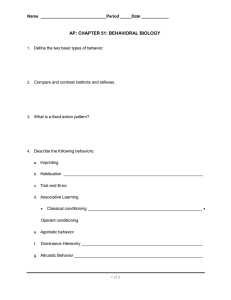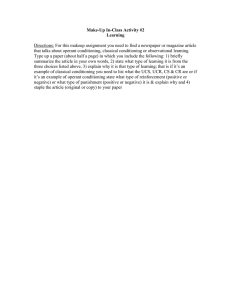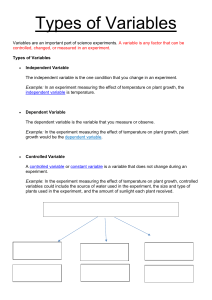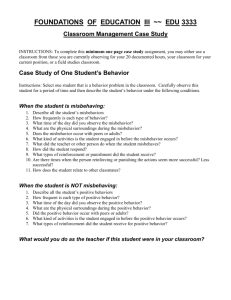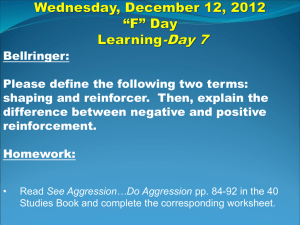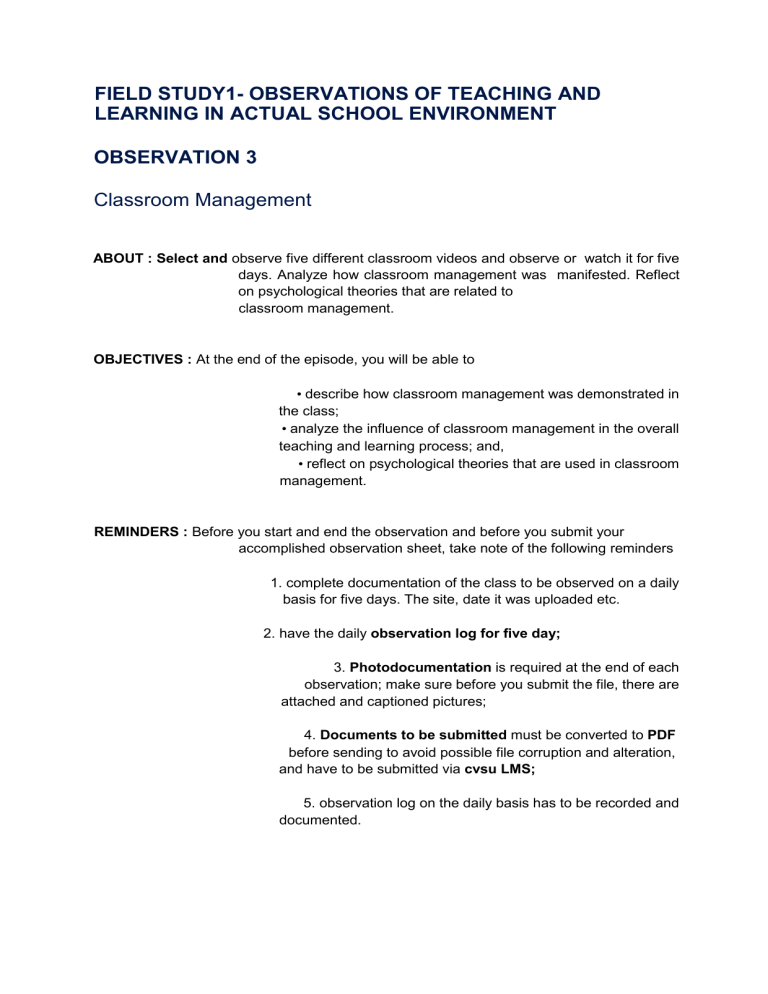
FIELD STUDY1- OBSERVATIONS OF TEACHING AND LEARNING IN ACTUAL SCHOOL ENVIRONMENT OBSERVATION 3 Classroom Management ABOUT : Select and observe five different classroom videos and observe or watch it for five days. Analyze how classroom management was manifested. Reflect on psychological theories that are related to classroom management. OBJECTIVES : At the end of the episode, you will be able to • describe how classroom management was demonstrated in the class; • analyze the influence of classroom management in the overall teaching and learning process; and, • reflect on psychological theories that are used in classroom management. REMINDERS : Before you start and end the observation and before you submit your accomplished observation sheet, take note of the following reminders 1. complete documentation of the class to be observed on a daily basis for five days. The site, date it was uploaded etc. 2. have the daily observation log for five day; 3. Photodocumentation is required at the end of each observation; make sure before you submit the file, there are attached and captioned pictures; 4. Documents to be submitted must be converted to PDF before sending to avoid possible file corruption and alteration, and have to be submitted via cvsu LMS; 5. observation log on the daily basis has to be recorded and documented. OBSERVATION 1.3: Classroom Management Name of observer Student No. Name of School School’s address Name of Teacher Date(s) of observation Time observed A. OBSERVATION 1. Describe the arrangement of furniture in the classroom, the arrangement of chairs and tables. Describe the materials posted / available in the classroom that aim to manage the class / student behavior. - based on what I saw on the 5 videos they do have quite the same arrangement of the things inside the classroom where we saw the chairs, teachers table and more and it is neatly and properly arranged. 2. Observe the teacher when delivering instructions. What does the teacher do before giving the instruction? How does the teacher deliver the instruction? What does the teacher do when the students understood / followed the instruction? What does the teacher do when students are not listening / fails to follow the instruction? - What the teacher did before giving instruction is checking how is her students also by doing prayer and some energizers. The teacher also deliver her lesson smoothly by following the 7 E’s. the teacher also made sure that the students is listening and if someone does not the teacher made sure to ask that specific student a question regarding on the lesson that they have. 3. Observe the teacher when discussing the lesson. How does the teacher respond to wrong answers of pupils? Correct answer of pupils? What is the response of the pupil in each case? Cite situations observed showing this. - The teacher did not take the wrong answers of the student instead the teacher take that also as an answer and ask another student to help that specific pupil so that it will be properly corrected. 4. Observe the teacher when addressing the student’s misbehavior. What misbehavior was observed? How does the teacher respond to the misbehavior? How the student and the rest of the class does responded? - So far, we've concentrated on preventing inconvenient or irritating behaviors. To organize classroom space intelligently, the teacher did set reasonable procedures and norms, pace courses and activities appropriately, and effectively explain the significance of learning, the guidance has all been proactive or forward-looking. Although we believe these concepts are vital, it would be naive to believe they are sufficient to prevent all behavioral issues. Chatting between two students, for example, can quickly expand to six students; one person's rudeness can quickly spread to multiple people; and so on. Delaying a response to incorrect behavior, as a result of this inclination, might make the task of getting kids back on track more difficult than responding as soon as feasible. That’s why it is really important that the teacher should set classroom guidelines. B. ANALYSIS 1. Classroom management strategies can be proactive or reactive. What proactive strategies were used by the teacher? What reactive strategies were used? - One of the example is Gesturing nonverbally and this is effective on the high school level up to college students. It is sometimes possible to communicate without speaking by employing gestures, eye contact, or "body language." If a student's misbehavior is just a little too serious or frequent to overlook, but not bad or frequent enough to warrant speaking to or talking with the kid, nonverbal clues are typically suitable. 2. Discuss how operant conditioning was applied in the class you have observed. Cite situations from your observations. - Positive reinforcement is encouraged by operant conditioning, which may be used in the classroom to elicit the good conduct you desire to and need to from your students. We build our habits and begin to comprehend what is proper and useful, as well as what isn't, through this process. And by that the teacher based on why observation did a great job in conducting their lesson flawlessly by also interacting to their students time to time. 3. Judging from how the teacher responded to correct and incorrect / proper and improper behavior, what will be its impact to the students? Support your answer with research findings. - Based on lumen educational psychology learning so far we have focused on preventing behaviors that are inappropriate or annoying. The advice has all been proactive or forward-looking: plan classroom space thoughtfully, create reasonable procedures and rules, pace lessons and activities appropriately, and communicate the importance of learning clearly. Although we consider these ideas important, it would be naïve to imply they are enough to prevent all behavior problems. For various reasons, students sometimes still do things that disrupt other students or interrupt the flow of activities. At such moments the challenge is not about long-term planning but about making appropriate, but prompt responses. Misbehaviors left alone can be contagious, a process educators sometimes call the ripple effect (Kounin, 1970). Chatting between two students, for example, can gradually spread to six students; rudeness by one can eventually become rudeness by several; and so on. Because of this tendency, delaying a response to inappropriate behavior can make the job of getting students back on track harder than responding to it as immediately as possible. C. REFLECTION 1. Reflect on operant conditioning theory. How important is this theory in classroom management? How would you use this theory in the future to effectively manage your class? - The way teachers manage their classrooms is crucial to creating a productive learning environment. Educators recognize that all kids learn in different ways, and that selecting the appropriate teaching style can help to reduce behavioral concerns while also allowing for effective education. The capacity of operant conditioning to explain learning in real-life situations is one of its advantages. Parents use rewards to cultivate their children's conduct from an early age. Praise given after a milestone (like as crawling or taking a first step) reinforces the habit. 2. Social learning theory states that people learn from observing others. How is this related to classroom management? How would you use this theory in the future to effectively manage your class? - Positive reinforcement and prizes can be used to encourage and teach desired behaviors in the classroom using social learning theory. A pupil who is complimented for raising their hand to speak, for example, is more likely to do it again. Teachers can engage with children who are acting out or having difficulty studying by understanding learning theories. The social learning theory's practical applications can immediately address behavioral concerns in some kids and assist them in improving. D. PHOTO DOCUMENTATION

